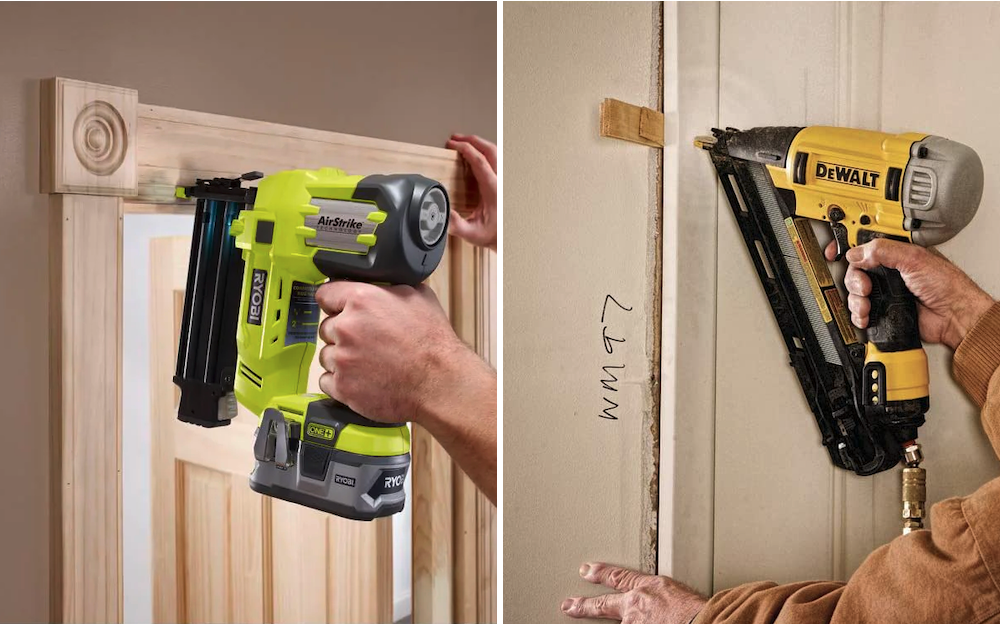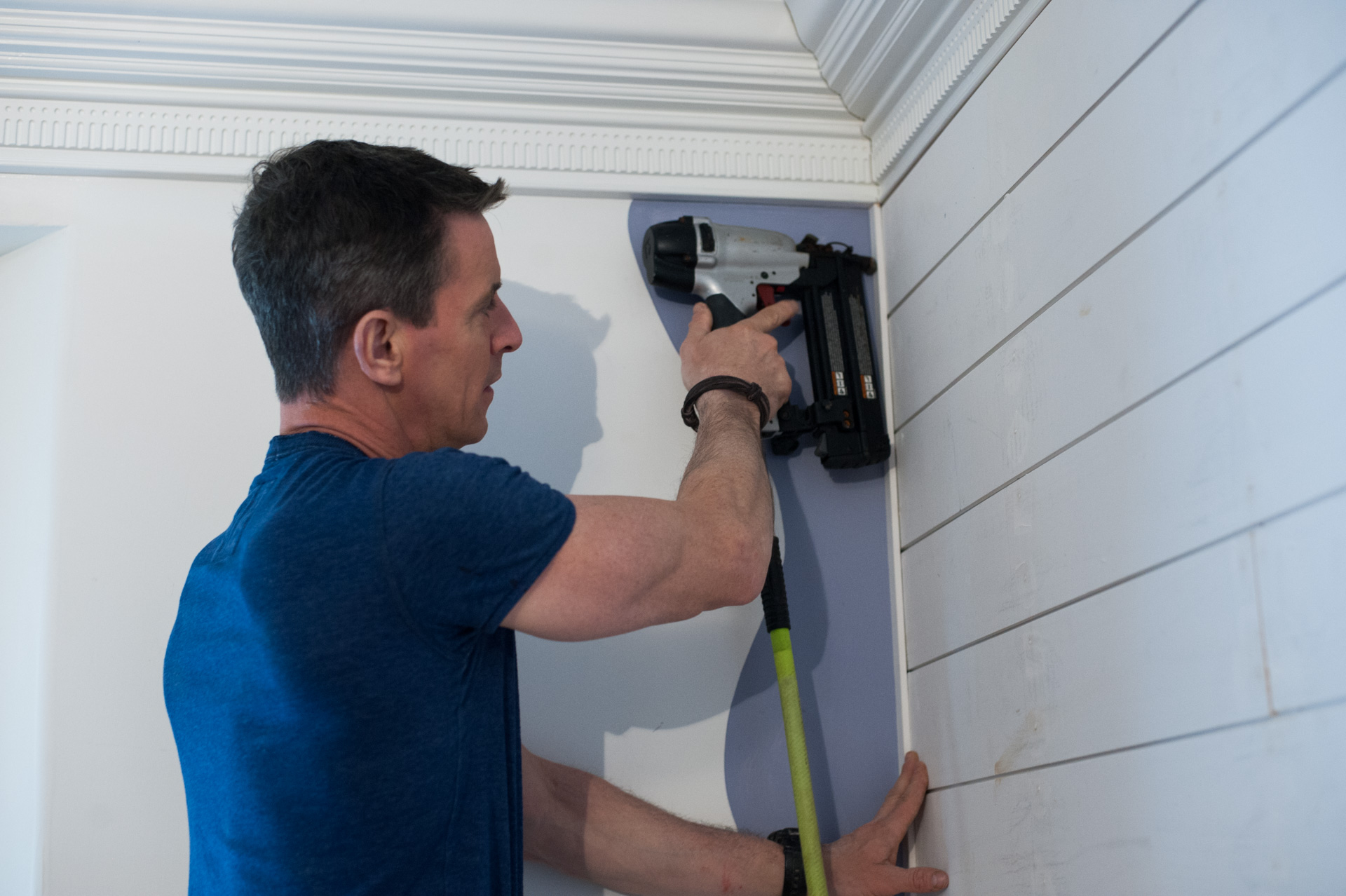

We may earn revenue from the products available on this page and participate in affiliate programs. Learn More ›
Put a brad nailer and a finish nailer side by side, and it might be difficult for novice DIYers to tell one from the other. There are subtle differences between the tools, however, that makes each one appropriate for certain kinds projects (and unsuitable for others). When it comes to evaluating the nails—the brad nail vs. finishing nail—they, too, look similar but serve pretty different functions.
If you have a project on the horizon for which you might need a nail gun, this guide will help clear up the brad nailer vs. finish nailer confusion. Ahead, learn about the technical differences between the tools, and the situations in which you would use one type of nailer and not the other.
Finish nailers are designed to shoot larger 16-, 15-, and even 14-gauge nails.
Nails are specified by gauge, which is the wire diameter used to make them. Higher numbers are thinner, and lower numbers are thicker. The thicker a nail, the more holding power it has.
The majority of finish nailers use thicker-gauge nails than brad nailers. Typically, finish nailers use either 16- or 15-gauge nails. A few 14-gauge models exist, but they are not common. Finishing nails vary in length from 1 to 3½ inches.
The larger nail diameter requires more force to drive it. For this reason, a finish nailer is more powerful and weighs a little more than a brad nailer.
| Easy for Novices to Use | Less Expensive | Suitable for Carpentry | Suitable for Crafting / Light Duty Work | |
| Brad Nailer | Y | Y | Y | Y |
| Finish Nailer | Y | N | Y | N |
Brad nailers use smaller, 18-gauge nails.

Brad nails (often just called brads), are 18 gauge, which is 0.0475 of an inch. They vary in length from ½ to 2½ inches. By comparison, a 16-gauge finish nail is 0.0625-inch thick. While the difference doesn’t seem like very much, the shorter length is a good indicator that a brad nail won’t hold material of the same maximum thickness as finish nails. They may not have the strength to penetrate hard timber either.
The benefit to being thinner is that the brad is less likely to split wood when going through it. Additionally, the head of the brad is less noticeable. Depending on the application of the brad nails, filling and sanding may not be required before painting, thus reducing the overall time a job takes.
For finishing touches on delicate projects, a brad nailer is best.

The easiest way to grasp the difference between a brad nailer and a finish nailer is to focus on the practical aspects of these tools and the jobs for which they are best suited.
A brad nailer is a light-duty tool. It might be used for adding narrow decorative moldings to plain panels or under stair treads. These tools are popular with crafters and model makers. They are often used for making birdhouses and bat boxes. Some woodworkers use brads as a temporary fix while glue dries because they are easy to remove and leave a very small hole.
Brads struggle with hardwoods, plywood, and dense particle boards like MDF. They simply aren’t strong enough to be driven through the denser materials. Most often they fold up on themselves, and they’ll sometimes jam the nailer. Therefore, a brad nailer is primarily used when working with softwoods.
Reach for a finish nailer for trim carpentry projects.
The finish nailer takes over when things get too big or too tough for the brad nailer: The finish nailer has the power needed for denser materials. It gets its name from being the tool that applies the finishing touches to construction tasks and is used for installing baseboards, crown moldings, window trim, and door casings.
While it’s an invaluable tool for the home remodeler, finish nailers are also popular with woodworkers. Finish nails are big enough to be used for furniture making (particularly carcasses) and other substantial workshop projects. That said, nail heads are still relatively small and easily hidden with filler.
THE TOOL FOR THE JOB
BOSTITCH SMART POINT BRAD NAILER KIT
In BobVila.com’s tests of the best brad nailers, the Bostitch fired 200 brads between 5/8 and 2 1/8 inches long and didn’t jam. The brads went into oak, ash, and pine boards without splitting any of the wood. The kit comes with a case, three no-mar tips, and a built-in pencil sharpener.
Looking for the right nailer for cabinetry or trim? Peruse BobVila.com’s tested guide to the best finish nailers.

Finish nailers offer two options when it comes to magazine designs.
While there’s little difference when looking at most finish nailers vs. brad nailers in physical terms, there is one type of finish nailer that is easy to identify. The angled finish nailer’s nail magazine isn’t at 90 degrees to the gun, it’s at either a 21-degree or 35-degree angle. This makes it easier to get the nailer into smaller spaces or when installing crown molding. Frequently the magazine is longer, so it has higher capacity and needs to be loaded less often.
However, almost all angled finish nailers take 15-gauge nails. As 15- and 16-gauge nails are not interchangeable, it’s important to choose the right tool at the outset. It could also be argued that it’s not as easy to nail at 90 degrees with an angled nailer, though the skill is soon learned. Brad nailers do not have angled magazines.
Both finish nailers and brad nailers come in cordless and pneumatic versions.

Having read about the brad nailer vs finish nailer question in some detail, you may now have a better idea of which tool is right for your upcoming projects. Keen DIY enthusiasts and remodelers might find they need one of each. However, there is another choice to be made: Is it better to buy a pneumatic tool (a popular professional’s choice) or a cordless model?
Pneumatic tools are much cheaper than cordless nail guns. In fact, it’s not unusual for them to be a quarter of the price. They are also lighter because they have no motor or battery. This also means there are fewer parts that could go wrong or wear out.
The downsides are that pneumatic tools need an air compressor to drive them (like the Bostitch finish nailer, above), which will be an extra expense if you don’t already own one. It also means you either need a convenient power outlet for the compressor or a generator to power them. Access to a compressor or power is seldom a problem on professional job sites, but it can be inconvenient at home. So while cordless brad nailers and finish nailers tend to be more expensive, they are easier for the majority of DIY users to manage.
Brad nailers are less expensive than finish nailers.
Given that brad and finish nailers are broadly similar (except for the power output), you might expect prices to be more or less the same. However, when making comparisons between tools from the same manufacturer, brad nailers are often 10 to 20 percent cheaper.
Not surprisingly there are big differences between the prices of budget tools and those from premium brands. It’s vital to thoroughly compare features to make sure you are getting value for money. If you’re in the market for either of these types of nailers, be sure to consult our guides to the best finish nailers and the best brad nailers we tested this year.
